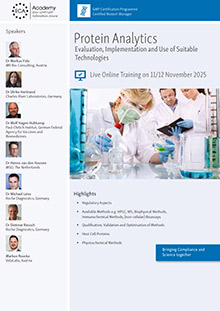Q&As Cleaning Validation - Part 2

Recommendation
5/6 February 2026
In September the ECA offered the first Cleaning Validation Online Training Course - with many questions asked by the participants. Last week's newsletter provided the first part of the Q&As, below you will find the second set of questions and answers, given by Robert Schwarz from the FH Campus in Vienna.
Selection of Q&As during Live Online Training Cleaning Validation. All answers reflect the opinion of the speaker based on his experience.
8. Question: For the manufacturing of solid oral forms: Our local authorities still insist that we need to re-introduce the 10ppm criteria even though PDE-values are available for all products produced in our facility. What could be the intention of this requirement?
Answer: Based on the information the only rational behind this request would be that the authority usually complains in this case, and which was also addressed in question 6 on Q&A on the "shared" facilities guideline, is the replacement of existing limits (e.g. 10ppm) by PDE-based limits, especially if these are higher:
"For existing products, manufacturer's historically used cleaning limits that should be retained and can be considered as alert limits, provided that when taking cleaning process capability into account, they provide sufficient assurance that excursions above the HBEL will be prevented. A similar process should be adopted when establishing cleaning alert levels for products introduced into a facility for the first-time."
9. Question: If e.g. one out of several swabs is OOS, is it possible to calculate the real carry-over from the achieved swab values and compare it to the MACO? So that not all relative (to surface) values need to be in spec but the final absolute carry-over value
Answer: No, on of the fundamental assumption that swab sampling could be performed is that the residues are evenly distributed on the surface. Additionally regulators generally see it critical if some sort of mean value calculation is performed (compare microbiological environmental monitoring according Annex 1).
10. Question: What to do first, swab or rinse, if you are doing both?
Answer: I would recommend to perform final rinse before swab sampling so no interference from swab sampling could affect the rinse sample.
11. Question: Which microbiologic method do you consider more representative/complete: rinsing, plates or swabbing?
Answer: Based on my experience recovery rates of rinse and contact plate sampling are often higher than those for swabbing. Some colleagues even call microbiological swabs a "qualitative" sampling. For sampling curved surface areas I even would recommend flexible contact plates over swabbing.
12. Question: For determination of cleaning agent residue: would a conductivity measurement in the final rinse be totally enough for a cleaning validation or should a direct sampling via Swab and TOC analytics be added at least to verify the results from conductivity?
Answer: If the composition of the cleaning media is a simple anorganic acid or base the concentration of it in the media and also final rinse sample has a high correlation factor to conductivity measurement. This is also one reason why especially for Biologics and Biotech products NaOH is frequently used.
13. Question: What are the regulatory requirements for recovery for swab tests during method validation, is there a percental limit?
Answer: There are no explicit regulatory requirements regarding chemical swab recovery rate. Common practice is e.g. reflected in PDAs TR No. 29; Section 6.5.2 "Swab/Wipe recovery":
"An acceptable swab recovery depends on how that swab recovery is being used. If the recovery is performed to qualify the sampling method without correction of either a limit or an analytical result then a recovery percentage such as 70% or more is typically required. If the recovery percentage is used to correct a residue limit or an analytical result then a recovery of 50% or more is typically required. An upper limit for percent recovery should be established to deal with studies where the measured recovery is greater than 100%. Recoveries of less than 50% typically require a written rationale of why that percentage is appropriate."
14. Question: Is it acceptable after CHT is exceeded to carry out only a disinfection of the equipment or is it obligatory to repeat the whole cleaning process?
Answer: Generally CHT has nothing to do with disinfection. Also, it is not advisable to disinfect product contact surfaces with potential risk of leaving disinfecting agent residues on the surface. It should be assessed on a risk-based approach if only final rinsing is sufficient or the whole cleaning process needs to be repeated.





